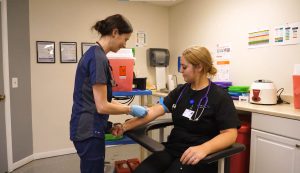A day in the life in a Medical Assisting career
April 27, 2015
There really is no “typical day” for a professional medical assistant. Your duties can vary depending on the healthcare facility you choose to work for, your specialty, and even the job description given to you from your employer. The balance of responsibilities can shift between clinical and administrative on any given day. Even then, a lot can happen that can alter your day.
At the start of your shift, especially if you are working a morning shift, it is important to prepare patient rooms for the rest of the day. This includes disinfecting instruments, ensuring sure all rooms have the appropriate equipment. Communicating with doctors and physicians is essential to ensuring you are properly setup for scheduled procedures (x-rays, minor surgeries, etc.) as well as maintaining order and efficiency.
Medical Assistants interact with patients when they arrive. You can be expected to help them get checked in, fill out admissions and insurance forms if necessary, take patient vitals, including pulse, blood pressure, temperature, height and weight; and ask about any allergies the patient has, current medications and medical history.
Throughout the day, your medical assisting tasks may shift between clinical and administrative duties, basically whatever needs to be done when it needs to be done. You can spend time calling patients to relay messages, share exam results or simply to follow-up with other concerns the patient may have. Other tasks include completing basic insurance and billing processes and answering phones. Medical Assistants then schedule follow-up visits, referral appointments and call in prescriptions.
At the end of the day or shift, it is crucial to make sure that loose ends from the day are tied up nicely. When finishing up with a patient, make sure they understand the diagnosis or treatment plan. Before leaving for the day, a medical assistant can be responsible for sanitizing all surfaces and equipment to prepare for the next shift, as well as, ensuring that all issues have been addressed and all information has been communicated as needed.
Making sure your medical facility is running as smoothly and efficiently as possible is a large responsibility, so be sure to take your role seriously.
More on starting a medical assisting career at First Institute:

